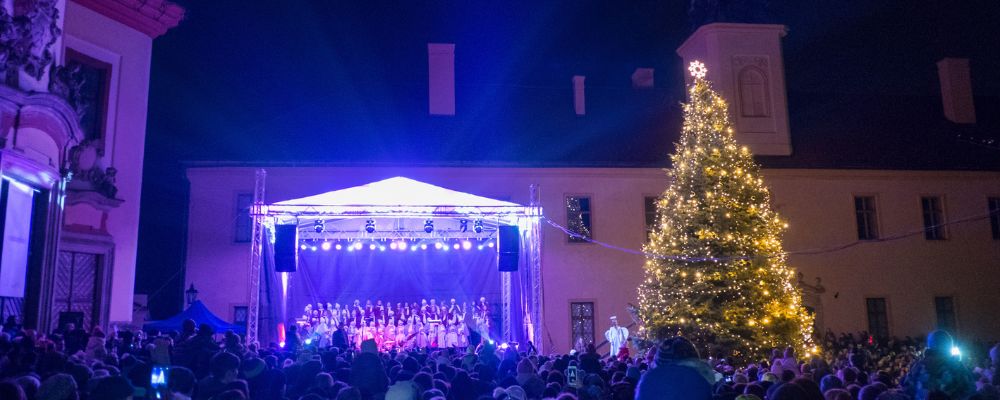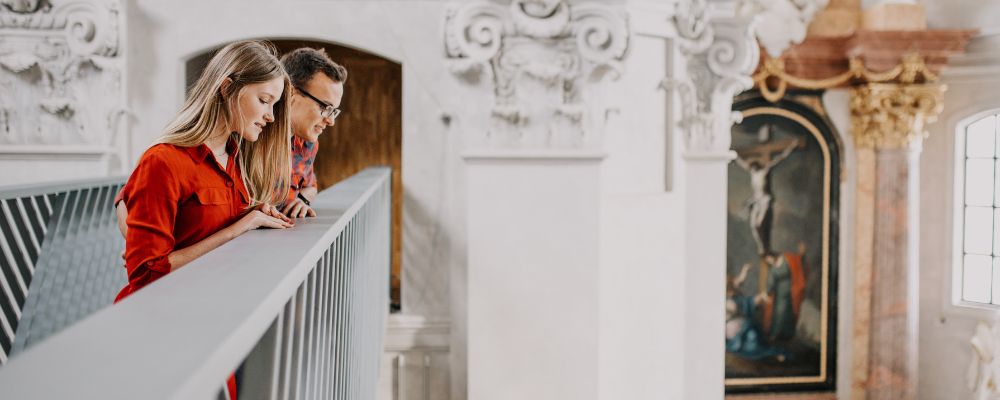
Litomyšl: A special event of Smetana's Art Litomyšl in 2016 will be an artistic intervention in the crypt of the Church of the Finding of the Holy Cross in Litomyšl. The Madonna of Osí- ka, the oldest surviving carving in our territory, will be on display here. The author of the exhibition is the architect Josef Pleskot, but he did not only modify the "exhibition space", but also gave the precious sculpture a new face, which he designed himself. The opening will take place on Thursday 9 June at 5 pm.
The mystery of the origin The ancient Romanesque statue of the Madonna and Child was discovered in the autumn of 2010 near Litomyšl in the village of Osík. Detailed art-historical and material research has shown that it is the oldest surviving polychrome carving in our territory (creation 990-1180). This unique cult object, which probably originated in north-eastern Switzerland, immediately became known as the Madonna of Osik. It is typologically one of the enthroned Madonnas with Jesus on their laps, the so-called sedes sapientiae type, the Throne of Wisdom. The almost millennium-old story of this unique object of personal devotion, imported to the Czech environment from far abroad, is still shrouded in mystery and awaits further research.
However, the Madonna bears one unnoticeable wound from the past - she is missing her face. It was probably cut off during one of the iconoclastic storms that swept through our country. The statue lost its meaning for several centuries, life drained out of it and it fell out of its natural place where it belonged. It has ceased to be a refuge for the existential pleas and reflections of people, a window to another world, a representation of transcendence and a link between the past and things to come.
The current exhibition of this Madonna in Litomyšl is driven by the desire to reverse this unfavourable course of history, at least for a few months, and to breathe life back into the statue and return it to its natural sacred environment. This unique Litomyšl experiment, which exceeds both domestic and foreign customs of presenting similar exceptional works of the past, is at the same time a great question mark about how we should carry the heritage of our own past today. It is an invitation to reflection and discussion.The face of the story of loss and the desire to rediscover
Architect Josef Pleskot says of the exhibition's main idea: "I need strong images to keep myself in good cultural shape. I am not a person who would seek out injuries and deformations, a person who would revel in a kind of aesthetics of scars and ruins. So the idea of a new face was born, and not just of this particular sculpture. It is not just the face of an ancient, precious statue! I also saw the task as a concentrated search for the face of our entire culture and identity, which has somehow been disappearing under our hands lately. We may be able to analyse this torso formally and materially, to place it somewhere, but all this somehow without a direct emotional relationship to this particular object and the idea it represents."
The curator and expert guarantor of the exhibition, Professor Jan Royt, Vice-Rector of Charles University and a leading Czech expert on medieval and early modern art, characterises the whole project as follows.
The second curator and co-creator of the whole concept, architect and head of the Centre for Theology and Art at the Catholic Theological Faculty of Charles University, Norbert Schmidt, adds, "Litomyšl is a small town, but nevertheless exemplary in the Czech Republic. Nowhere else have they embarked on the complex task of unravelling the relationship between the old and the new, specifically the bold contemporary realisations in the historic centre of the town, with such determination and courage. In fact, the Face exhibition summarises what has been consistently practised here since the early 1990s, using only a small but exclusive example of a Romanesque Madonna and Child Jesus." "For centuries, the Virgin Mary has also become a projection screen, an archetypal image of the virgin, woman and mother. She became an inspiration for art and poetry, the embodiment of the ideal of femininity of that time. The figure of Mary, by the way the most popular motif in the history of art, has profoundly influenced our entire Western understanding of man."
The exhibition is held under the auspices of Daniel Herman, Minister of Culture of the Czech Republic, and H. Em. "I am happy to accept the patronage, because although in this case it is a torso of a work of art, I think that these works should not be hidden in depositories, but should also refer to our roots and to the heritage of previous generations and develop them with their presence."
The Face exhibition is on view in the crypt of the Church of the Holy Cross from June 9 to December 31, 2016. It will be open from June to September daily from 2-6 pm and during the evening programmes of the International Opera Festival Smetana Litomyšl, and from October to December it will be open on weekends and public holidays from 2-6 pm, or on request. The opening will take place on 9 June 2016 at 5 pm in the presence of Cardinal Dominik Duka OP, the Mayor of Litomyšl Radomil Kašpar, architect Josef Pleskot, curators Jan Royt and Norbert Schmidt.
The exhibition will be accompanied by a varied programme of lectures, debates and other events. More information can be found on the exhibition website: http://www.tvarlitomysl.cz/
The first public panel debate, entitled Searching for a Face, will take place at the Church of the Exaltation of the Holy Cross in Litomyšl on Friday 10 June at 6 pm. Martin Janda, Josef Pleskot and Jan Royt will take part. The moderator will be Norbert Schmidt.
The architect Josef Pleskot (* 1952), known for the transformation of the Lower Vítkovice area in Ostrava or the design of the passage through the mound in the Deer Moat at Prague Castle, has been working in Litomyšl since the early 1990s. He designed the U Nemocnice apartment buildings, the Loučná river embankment, as well as the reconstruction of the castle brewery and the Regional Museum and the new parterre of the Castle Hill. For the Zdeněk Sklenář Gallery, he created the public art space "1 art for art" and collaborated with the sculptor Aleš Veselý on an exhibition in the city streets. In May 2016, he was named an honorary citizen of Litomyšl.


